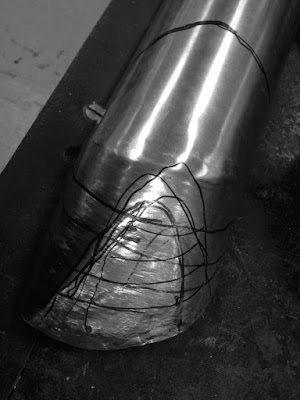Follow the steps from tutorial one till you get 3D model to shape the metal skin.
Step 1: Mark out and cut the metal sheet into 150 mm* 300 mm sheet just enough to cover the selected half of tree trunk form-work.
Step 2: Using the roller and fit the sheet to a suitable level and start bending to follow the curve shape of form-work. Need to check visually, because you don't want the sheet to over bend and stop rolling once you got the desired curve.
Put the 3D model and roll metal sheet to check if it fitting well and it is always good to use 3D model as a reference.
Step 3: Both curve end sides need to be flatten to fit in 3D model perfectly, use the flat hammer to flatten the curve.
Step 4: After flatten out the both sides, the sharp edges need to cut off for better contour of the 3D model. And start marking the skin to shape the contour.
Step 5: At this stage, use the timber form work which curve shape is closest to 3D model as a base and start pushing down with mullet according to marked contour lines. Keep pushing down till you get the desired contour. Try to use both hands to maneuver the metal to maintain the curve shape.
Step 6: Once the desired contour is achieved on one side, put the 3D model back into the sheet to mark out and cut off unnecessary bits on the other end. This will allow you to save energy and time.
Step 7: Start marking the skin to shape the contour at the other end.
Step 8: Use the timber form work as a base and start pushing down with mullet according to marked contour lines. Keep pushing down till you get the desired contour.
Tips: It is good to check with 3D model regularly because once the metal sheet was bent to a certain level, it is too difficult to bring it back. Minimize the gaps between 3D model and metal skin for a better contour.
FINAL RESULT
I was fairly pleased with how the skin turned out at the end, thanks to Mathew’s kind advice throughout the process. The longer time spending in the workshop, the more familiar with the tools and easier to shape the metal sheet. Experimenting with different tools is crucial because only with the right tools, the desire result can be achieve. Helping each other in the workshop and taking turns to use the tools is fun. Important thing I learnt from this metal sheeting experience was that working together with students from other discipline allow me to look at the things from different perspectives which is beneficial for me as an Architecture student. This course prepare me to work in built environment with others in a professional manner.




















No comments:
Post a Comment